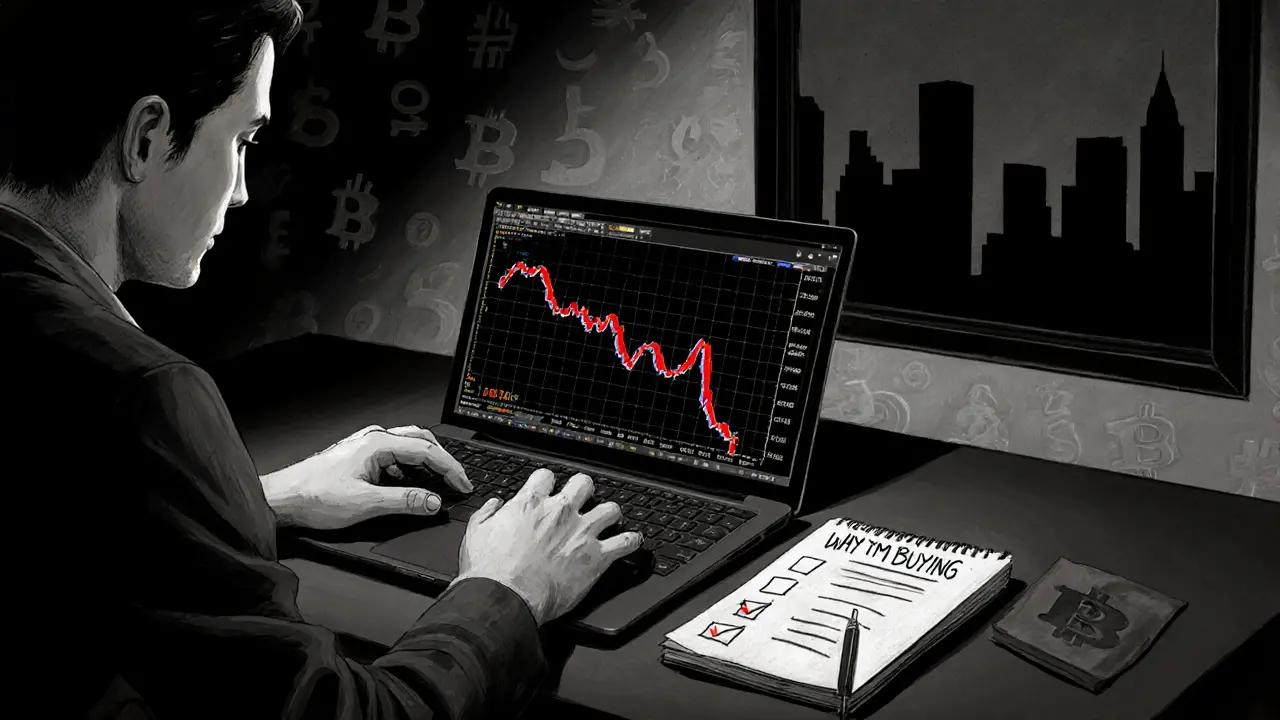
Crypto Sentiment Analyzer
Use this tool to calculate current market sentiment based on multiple indicators described in the article. Input values for various sentiment metrics to determine if the market is in extreme fear, fear, neutral, greed, or extreme greed. This helps identify contrarian trading opportunities.
Sentiment Analysis
Most traders chase the latest hype, buying when everyone’s excited and selling when panic sets in. That herd behavior creates big mispricings - especially in the fast‑moving crypto space. Contrarian investing flips the script: you step against prevailing feelings and let the market correct itself. This guide shows exactly how to blend sentiment analysis with a disciplined contrarian mindset, so you can spot opportunities before they become obvious.
What is Contrarian Sentiment Investing?
Contrarian Sentiment Investing is a strategy that deliberately takes positions opposite to the dominant market mood, using quantitative sentiment signals to time entries and exits. It builds on the classic Buffett adage - be fearful when others are greedy - but adds a modern data‑driven layer. By measuring how excited or scared investors are across news, social media, and market‐based gauges, you can spot when prices have drifted far from intrinsic value.
Sentiment Analysis - The Engine Behind the Strategy
Sentiment Analysis refers to the systematic extraction of positive, neutral, or negative tones from textual or numeric data. In finance, it turns headlines, tweets, and surveys into concrete numbers that can be compared against historical thresholds. When combined with a contrarian bias, these numbers become triggers for buying low (when fear peaks) or selling high (when greed spikes).
Core Sentiment Indicators to Watch
Several market‑based gauges have proven predictive power for contrarian moves. Below is a quick cheat‑sheet you can paste into a spreadsheet or monitoring dashboard.
- VIX - the CBOE Volatility Index. Readings above 30 signal extreme fear; below 15 suggest complacency.
- Put/Call Ratio - values >1.0 indicate bearish crowd sentiment.
- Bullish Percent Index (BPI) - below 30 % on major indices hints at oversold conditions.
- AAII Sentiment Survey - weekly retail‑investor poll. Bullish sentiment >57.5 % historically precedes negative market months.
Each indicator works best when you look for divergence: for example, a soaring VIX while a cryptocurrency’s on‑chain fundamentals stay solid.
Sentiment Data Sources (Crypto‑Focused)
Crypto markets generate a torrent of real‑time chatter. Here are the most reliable feeds for sentiment numbers:
- StockTwits - offers a sentiment‑score API that aggregates tweet‑like posts about specific coins.
- RavenPack - a commercial platform that processes news, Reddit, and forum data into a single “Sentiment Index”.
- Bloomberg Sentiment Score - provides professional‑grade sentiment for major crypto assets via its terminal.
- Free alternatives such as the AAII Sentiment Survey (applies to equity sentiment but often mirrors crypto risk appetite) and the popular Fear & Greed Index on alternative.me.
Most retail traders start with StockTwits and the free Fear & Greed Index, then graduate to RavenPack once the strategy shows consistent returns.

Building a Contrarian Sentiment Strategy - Step by Step
- Define the asset universe. Focus on 5‑10 coins you understand (e.g., BTC, ETH, SOL, DOT, AVAX).
- Collect multi‑timeframe sentiment. Pull daily scores from StockTwits, weekly AAII/Bullish Percent data, and monthly news sentiment from RavenPack.
- Set extreme thresholds. Example: Buy when VIX > 35 *and* StockTwits sentiment < 30 % for the target coin.
- Fear threshold: VIX > 30, StockTwits < 30 %
- Greed threshold: VIX < 15, StockTwits > 70 %
- Cross‑check fundamentals. Ensure the coin’s on‑chain metrics (active addresses, hash rate) remain healthy. This avoids “value traps” where sentiment is low because the project is failing.
- Active addresses growth > 5 % MoM
- Developer activity on GitHub > 10 % increase Q‑over‑Q
- Determine position size. Most practitioners risk 1‑3 % of total capital per contrarian trade.
- Use a stop‑loss at 8‑10 % below entry.
- Take partial profits once the sentiment index moves 20‑30 % toward neutral.
- Monitor for reversal signals. If VIX drops below 20 *and* sentiment swings back to neutral quickly, consider exiting early.
Stick to the checklist religiously - the biggest edge is discipline when the market is screaming the opposite of what you’re doing.
Risk Management & Psychological Discipline
Contrarian sentiment plays are notorious for “catching falling knives”. The key is to limit exposure while staying patient.
- Position sizing. Keep single‑trade risk under 3 % of portfolio.
- Hard stop‑losses. Pre‑set exit levels; don’t move them as fear rises.
- Time‑based exits. If a trade hasn’t moved after 30 days, consider closing regardless of sentiment.
- Psychology hacks. Write a short “why I’m buying” note before each trade and review it when the price drops.
Studies by behavioral economist Richard Thaler remind us that markets can stay irrational longer than our capital lasts. The discipline framework above is the practical antidote.
Tools & Platforms Comparison
| Platform | Data Sources | Real‑time Score | Pricing (2025) | Best For |
|---|---|---|---|---|
| StockTwits API | Twitter‑like posts, Reddit snippets | Live | Free tier; $19.99/mo premium | Retail traders seeking cheap, fast sentiment |
| RavenPack Context AI | News, social media, earnings call transcripts | Minute‑level | $2,500/mo | Quant funds needing deep NLP coverage |
| Bloomberg Terminal | Global newswire, proprietary surveys | Real‑time | $24,000/yr | Institutional traders with full‑suite workflow |
| AAII Sentiment Survey | Retail investor poll (U.S.) | Weekly | Free membership | Baseline gauge of market mood |
| Alternative.me Fear & Greed Index | Crypto‑specific news, volatility, social media | Daily | Free | Quick snapshot for hobbyists |
Most successful contrarian investors start with StockTwits and the free Fear & Greed Index, then layer in a premium tool like RavenPack once the strategy scales.

Real‑World Crypto Examples
Below are two recent case studies that illustrate the payoff - and the pitfalls - of going against the crowd.
- Bitcoin - March 2023 fear rally. VIX spiked to 36 and StockTwits sentiment for BTC fell to 28 %. After confirming that on‑chain activity (hash rate, active addresses) stayed robust, a 3 %‑of‑portfolio long was entered at $27,800. Within 45 days, sentiment normalized, and Bitcoin rose to $38,200 - a 38 % gain.
- Solana - August 2022 over‑optimism. The Fear & Greed Index hit 85 % (extreme greed) while Solana’s network upgrades were delayed. A short position of 2 % capital was taken at $115. The market kept climbing to $170 before finally correcting, delivering a modest 12 % profit but also a painful drawdown when the price surged.
The first trade succeeded because the sentiment extreme was not backed by a structural problem; the second illustrates why you must always verify fundamentals.
Getting Started Checklist
- Choose a primary sentiment platform (StockTwits or RavenPack).
- Set up alerts for VIX > 30 and sentiment < 30 % on your target coins.
- Build a simple spreadsheet that logs entry price, sentiment level, on‑chain metrics, and stop‑loss.
- Back‑test the rule set on the past 3‑year price data (most platforms offer CSV export).
- Start with a pilot allocation of 5 % of total capital and scale only after consistent 2‑year performance.
Follow the list, keep a trading journal, and treat each trade as a data point for refining the model.
Frequently Asked Questions
How extreme does sentiment need to be before I consider a trade?
Most practitioners use the 90th percentile thresholds: VIX > 30, StockTwits sentiment < 30 % for fear, or AAII bullish sentiment > 57.5 % for greed. These levels have historically produced a 60‑plus % chance of a market reversal within the next month.
Can I use contrarian sentiment investing with fiat‑only assets?
Absolutely. The same indicators (VIX, Put/Call Ratio, AAII Survey) apply to stocks, ETFs, and even commodities. The key is pairing sentiment extremes with solid fundamentals for the specific asset class.
What’s the biggest mistake new contrarian traders make?
Skipping the fundamental filter. Buying a coin solely because sentiment is ultra‑negative often leads to value traps when the project is genuinely failing. Always verify on‑chain health or earnings quality before entering.
How often should I rebalance my contrarian positions?
A quarterly review works for most crypto portfolios. If a sentiment extreme persists beyond 90 days, consider scaling out or tightening stop‑losses.
Do I need a pricey data vendor to be successful?
No. Many retail investors achieve good results using the free StockTwits API and the weekly AAII Survey, as long as they respect strict risk limits and combine sentiment with fundamentals.

Great overview of contrarian sentiment investing. I especially like the reminder to pair sentiment extremes with on‑chain fundamentals, because ignoring fundamentals is the fastest way to get burned. The checklist format makes it easy to turn the theory into a repeatable process. Keeping a short “why I bought” note, as you suggested, is a habit that even seasoned traders can benefit from.
The guide, while comprehensive, suffers from an occasional lack of depth in the explanation of why certain sentiment thresholds actually correlate with price reversals. For instance, stating that “VIX > 30 indicates extreme fear” is accurate in equity markets, yet the crypto volatility environment often deviates due to algorithmic trading and market‑making dynamics. Moreover, the omission of a detailed discussion on the statistical significance of the chosen thresholds leaves the reader to assume causation where merely correlation may exist. It would also have been valuable to see a back‑testing framework that accounts for survivorship bias inherent in selecting only the most successful case studies. The sections on risk management correctly emphasise position sizing, but they could be expanded to include a discussion on drawdown‑based capital allocation methods. Finally, the comparison table, while useful, does not address the latency differences between free and premium data feeds, a factor that can materially affect entry timing for high‑frequency contrarian trades. Overall, the article provides a solid starting point, but it would benefit from a deeper quantitative analysis to truly satisfy the more rigorous traders.
The article does a solid job of outlining the mechanics of contrarian sentiment trading, however, it could benefit from a more explicit discussion of how to integrate on‑chain metrics, such as active addresses and hash‑rate, with traditional sentiment indicators, like VIX and the put/call ratio, to form a more robust entry signal. Additionally, while the checklist is helpful, adding a step that involves periodic review of the correlation between sentiment scores and actual price movements would enhance the discipline aspect, ensuring that traders do not become overly reliant on any single data source, which, as we know, can be noisy, especially during periods of heightened market stress.
People who chase hype without checking fundamentals are just feeding the market’s stupidity. If you’re not scared of losing money, you’re probably already lost.
What you don’t realize is that the data feeds themselves are often manipulated by a handful of whales and insider bots; the “objective” sentiment scores are just another layer of the illusion, designed to keep retail traders dancing to the tune of hidden algorithms.
For anyone just starting out, I’d suggest using the free StockTwits API first and setting simple alerts for VIX over 30 and sentiment under 30 percent. Keep it simple and focus on the fundamentals before you upgrade to pricey tools.
The beauty of contrarian sentiment lies in its reminder that markets are driven by human emotion, which is both predictable and chaotic. When fear spikes, it reveals a collective bias that can be mathematically quantified, yet the underlying cause often traces back to deeper narratives about trust, scarcity, and the future of technology. By embracing this duality, you not only position yourself for potential upside, but also gain a richer appreciation for the psychology that fuels crypto’s volatility. Remember, discipline is the bridge between insight and profit, and a well‑crafted checklist can serve as that bridge. In practice, start small, observe the feedback loop, and let the data guide incremental adjustments.
Exactly, the checklist acts like a compass in the storm; it keeps you from drifting into the hype‑filled whirlpools, and it reminds you to verify on‑chain health before committing capital.
Don’t let the fear of missing out paralyze you – use the sentiment extremes as a signal, not a command. Set your stop‑losses and stick to them, even when the market screams otherwise. Keep your trade size modest, like 1‑2% of your portfolio, so a single mistake won’t wipe you out. And always double‑check the on‑chain data; a healthy hash‑rate or growing active addresses can turn a fearful market move into a golden entry.
The concept of contrarian sentiment investing is not a novel invention; it harkens back to the age‑old wisdom that markets overreact to collective emotions, a principle that can be observed in everything from tulip manias to modern crypto fiestas. When investors collectively rally around optimism, prices often inflate beyond any rational valuation, creating a bubble that eventually bursts as reality asserts itself. Conversely, during periods of panic, fear drives prices down to levels that can seem irrationally low, offering savvy traders a chance to acquire assets at a discount. In crypto, this dynamic is amplified by the 24/7 nature of markets and the rapid dissemination of information across social platforms, making sentiment swings both swift and pronounced. The VIX, traditionally a gauge of equity market volatility, has found a new home as a proxy for risk appetite among crypto participants, especially when paired with crypto‑specific indices like the Fear & Greed Index. However, reliance on any single metric can be misleading; the true power lies in the convergence of multiple signals: a soaring VIX, a plunging StockTwits sentiment score, and a simultaneous dip in on‑chain activity can together paint a compelling picture of extreme fear. Yet this picture is only as accurate as the data feeding it, so using reputable sources such as RavenPack for news sentiment and corroborating with on‑chain analytics tools can mitigate the risk of false positives. Risk management, as highlighted in the guide, remains paramount because contrarian trades often feel like “catching a falling knife,” a phrase that evokes both the danger and the potential reward. Setting predefined stop‑loss levels, limiting position size, and establishing time‑based exits are all safeguards that transform speculative bravery into disciplined strategy. Moreover, maintaining a trading journal that records not only entry and exit points but also the emotional state at the time can reveal personal biases that might otherwise cloud judgment. It is also worth noting that not every extreme sentiment episode will result in a reversal; sometimes fundamentals deteriorate alongside sentiment, and a true value trap ensues. Therefore, a quick fundamental sanity check-examining metrics like active addresses, developer activity, and network health-can act as a filter to weed out those traps. Ultimately, the art of contrarian sentiment investing is a dance between data and psychology, where the trader must remain vigilant, adaptable, and, above all, patient. By embracing the discipline outlined in the guide, traders can position themselves to profit when the herd inevitably turns back, turning the very fear of the crowd into a source of personal gain.
I’m curious about how often the sentiment thresholds you mention actually lead to profitable trades in practice. Have you looked at a rolling window of, say, the past twelve months to see the hit‑rate, or is the guidance more of a rule‑of‑thumb based on anecdotal evidence? Knowing the statistical edge would help many of us decide how aggressively to allocate capital to this approach.
Honestly, if you’re still reading this guide and haven’t started shorting the hype, you’re basically watering your portfolio with regret. Get over yourself and let the data do the talking.
Great post! The integration of sentiment analytics with on‑chain fundamentals creates a hybrid signal that’s both top‑down and bottom‑up, which is exactly the kind of multi‑layered strategy we need to navigate the crypto terrain.
The psychological tug‑of‑war in crypto can feel like an endless battle, but remembering that fear is a market’s catalyst, not its master, can give you the mental edge to stay the course when others panic.
Oh wow, another “how to beat the crowd” guide 🙄-because the crowd is so original. If you wanted something groundbreaking, you could try not losing money while chasing memes 🤦♀️. Anyway, the steps are solid, just don’t forget to bring popcorn for the rollercoaster 🎢.
Sounds like hype to me.